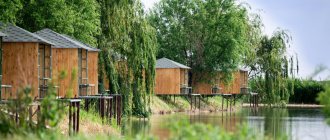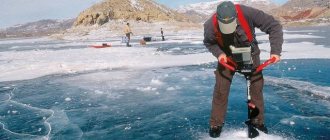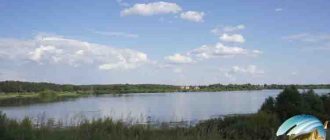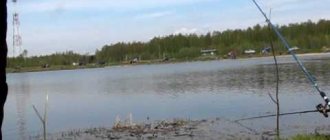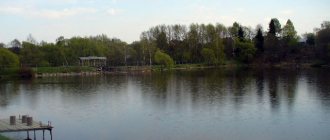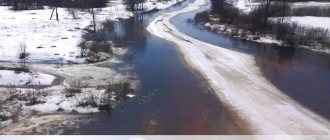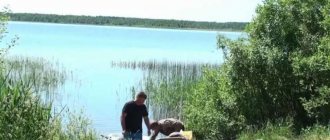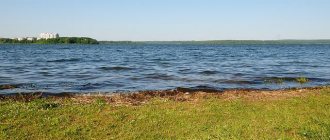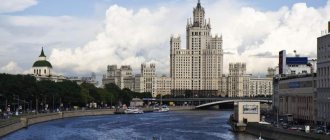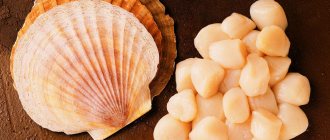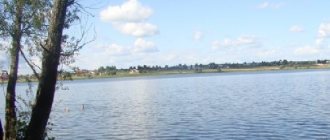Black Lake
This reservoir arose on the site of a deep quarry, and clean water is its calling card. The lake has wonderful scenery, so fishing can be a great activity for families with children. The smell of a coniferous forest and the chirping of local birds will allow you to take your mind off routine everyday life, and the bite of crucian carp and rotan will make fishing more fulfilling.
How to get there:
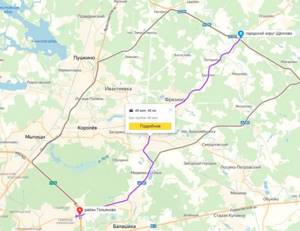
By car:
Along the Shchelkovskoe or Yaroslavskoe highway, exiting onto the Fryanovskoe highway, a little over an hour on the road from Moscow. The lake is located 38 kilometers from the Moscow Ring Road near the intersection of the A107 highway and the Fryanovskoe highway.
By public transport:
From the Shchelkovskaya metro station by bus 335K (Moscow-Fryanovo) to the Betonka stop (39 stops), approximately 1:30 hours on the way. Then cross the A107 highway for 500 meters (about 8 minutes on foot from the stop).
Coordinates:
56.040902, 38.204376 (click on the coordinates to open the location on the maps)
Top 11 fishing places in Russia
Elk Island. This place is located near Moscow, just a couple of kilometers from the Moscow Ring Road. Therefore, it is always quite crowded here, but there is enough fish for everyone. This place appeared in 1983, and every year it becomes bigger and bigger. It is very beautiful here, the water is clean, without whirlpools of mud and debris. There are carp, crucian carp, pike, catfish, sturgeon and many other varieties of fish. Losiny Island is a nature reserve, so entry into its territory is paid.
- Akhtuba. This place is located in the Volgograd region. A large number of catfish and pike of gigantic size are found here, since the bottom of the lake is dotted with a large number of deep holes. It’s worth coming here for those who want to catch a really big catch, because the fish here are incredibly large. In general, a real paradise for fishermen, the main thing is to stock up on strong fishing line.
- Rybinsk Reservoir. The name of the place speaks for itself. The reservoir is located near the cities of Volgograd, Tver and Yaroslavl. There are a wide variety of fish species found here. You can fish from the shore or from a boat.
Lower Volga. All professional fishermen and amateurs know what kind of catch can be caught in the Volga. This place is definitely one of those places worth visiting. Here you can stay with a tent for several days or rent a hotel room. Sturgeon, stellate sturgeon, beluga and many other types of fish are found here.
- Klin reservoir. For fishing lovers from Moscow, this can be said to be an ideal place. There are a lot of bream, crucian carp, burbot, pike, perch, ide, and pike perch here. And getting to the ship doesn’t cause any problems. The reservoir is quite large, so there is a place for everyone to relax. You can stay in a village or set up a tent camp. Fans of comfortable and paid fishing can go to the village of Novoselki, and the rest can independently find a fishing spot on the shore.
- Seliger. Lake Seliger is located in the Tver region. Quite a lot is known about the lake itself, but few people talk about how good the fishing is here. This is a real paradise for fishermen. Here you can find burbot, carp, roach, pike perch, pike, rudd and eels. An excellent holiday option with the opportunity to bring home a rich catch.
Lake Yanisyavrvi. This fish pond is located in Karelia. The lake is of meteorite origin; along the banks there is a pine forest. Fishermen from all nearby regions come here for a big catch. The lake is home to a variety of fish species, and there is also a recreation center nearby. There is even an opportunity to hunt in these places. In Karelia, by the way, there are many other reservoirs rich in catch.
- Lake Onega. Also located in Karelia. This is the place where you can come with one fishing rod and leave with a rich catch. Trout, pike, grayling, salmon and hundreds of other species of fish are found here. This is a great place for trophy fishing. At the nearest recreation centers you can rent a boat with a crew. You can also get lessons for beginning fishermen here.
- Angara. This is one of the largest rivers flowing from Lake Baikal. The place is located in the Irkutsk region. Here you can find taimen, sorog, dace, pike, tugun, perch, sturgeon and other types of fish. You can fish directly from the shore or take a boat and get to the center of the reservoir.
Mzymta. This river is located in the Krasnodar region, its length is about 90 kilometers. Fishermen boast that here you can catch fish weighing 15 kilograms or more. The main advantage of this place is that it is accessible all year round, the water here does not freeze, so you can fish at any time. You can catch carp and silver carp here; there are also lakes with trout farms nearby.
- Sudak in Crimea. There are two main and most popular fishing spots in Sudak. This is Mount Alchak-Kaya with a fantastic view of the surrounding natural beauty. In addition to the variety of fish, you can also catch crabs, mussels or shrimp here. The second place is the city pier next to the old fortress. But here it is better to have an echo sounder for fishing, since there are a lot of people and a large number of swimming devices on the surface, which leads to active migration of fish.
Lake Biserevo
Experienced fishermen often visit this reservoir, as it is rich in a variety of prey. Fans of predators can try their hand at fishing for striped robber or pike, and for lovers of peaceful fishing, cupid, carp and crucian carp, and bighead carp will be excellent prey. Biserevo is a picturesque lake with shallow depth. The vast territory occupied by the reservoir will provide accommodation for a large number of vacationers. The bottom is usually muddy, but the southern coast has sand.
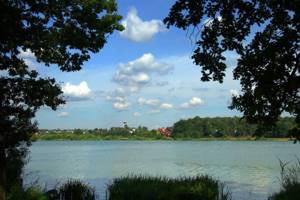
How to get there:
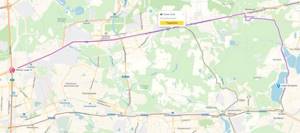
By car:
Along the Enthusiasts Highway (hereinafter referred to as Gorkovskoye Highway), or Nosovikhinskoye Highway to Biserevskoye Highway, about 30 minutes on the road from Moscow. The lake is located 22 km from the Moscow Ring Road, next to Biserevskoye Highway.
By public transport:
From Kursky station by train to Kupavna station (48 minutes on the way), then either 2 km on foot, or after 1 stop by bus 37, or minibus 29, 57 to the “Cafe” stop, from the stop just cross the road to the lake.
Coordinates:
55.766177, 38.116377 (click on the coordinates to open the location on the maps)
Molokcha River
You will have to get to the river by car, going towards Makhra through the village of Karabanovo. In the summer you can catch silver bream, roach and pike from the shore, and in the fall it makes sense to come hunting for burbot. Fishing from a boat is made difficult by the presence of obstructions of branches and snags. However, near the shores it is too shallow for float fishing. The water in Molokcha is often cloudy, especially in summer, when the water area begins to bloom. Along the banks of the reservoir there is a dense forest, and on the southern side there is a small swamp.
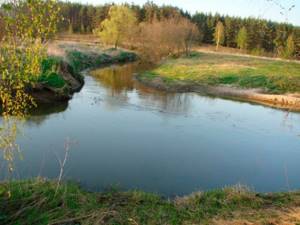
How to get there:
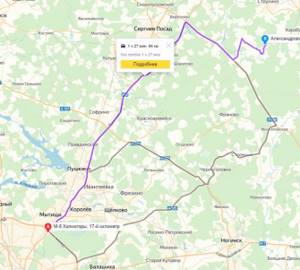
By car:
Take the Yaroslavskoye Highway to the A-108 highway, turn onto it towards Dmitrov, get there, turn towards Strunino at the traffic light, drive along Shosseynaya Street and turn towards the village of Lizunovo, then drive along the road to the village of Perematkino. The distance from Mkada is 94 km and an hour and a half on the road.
By public transport:
It will not be very easy to get to the river by public transport, but if you still decide, the easiest way will be to get from the Yaroslavsky railway station to the Strunino station (2 hours on the way), then it is best to take a taxi and point in the direction towards the river, or village of Perematkino. The taxi ride takes about 20 minutes.
Coordinates:
56.291923, 38.571790 (click on the coordinates to open the location on the maps)
When to catch
In early spring, pike come close to the shores. At this time, pike spawning usually takes place, while banks appear and water floods the banks. Before spawning, if you manage to get there in this short period of time, the pike will feed heavily. At this time it bites very well and at the same time not far from the shores. Even large specimens can be found near the shore at this time.
After spawning, the pike rests for some time, and then after about two weeks the main feeding period of the pike begins. It also lasts for 2-3 weeks, but it is at this time of year that the pike bites best. At this time it stays close to the shore and bites almost all day.
In summer there is a slight lull, during which the bite weakens with the onset of heat. The hotter the heat, the worse the bite. Pike does not stop feeding completely, but it does so rarely and more in the early morning and evening, as well as at night, when the sun sets and it gets cooler. Pike tend to stay close to the shore, near grass, various snags and submerged stumps. Small pike and medium-sized fish live and hunt here. Only large pike prefer to stay away from the shores in the depths almost all the time of the year.
At the end of summer, when it gets cooler, pike begin to bite better and more often. And when autumn comes and it becomes even colder, the pike begins the so-called autumn zhor. It is, of course, not as active as after spawning, but at this time the pike is preparing for winter and bites almost all day. And it bites well. It’s not for nothing that pike fishing enthusiasts love autumn and consider it the main season for pike fishing.
Read: Asp. Summer fishing of a spinner
In autumn, pike already begin to move away from the shore itself and are practically not caught in the shallows. Pike always follows where its main food - small fish - moves. In autumn, pike can still be caught near coastal grass thickets, but it is still worth looking for it in deeper places. On calm and warm days, pike leave deep places and come closer to the shore. But when it’s damp, cloudy and cold, you won’t be able to find pike near the shore. You need to fish where it is deeper and where there is enough food for the pike. It is in the autumn that fishing for pike is most pleasant, and there is a high probability of catching a good trophy specimen.
The bite can become especially intense closer to freeze-up. Just before the formation of ice on the reservoir and in the first couple of weeks after the ice forms, the pike bite is especially good and stable.
Pakhra River
Muddy water with riffles, in which asp, ide and chub are found, attracts anglers from all over the region. It is best to stop at widenings, as well as gentle turns of the river. You can get there by heading towards the village of Novlenskoye. Many anglers park their vehicles right next to the dam, but fishing is prohibited in this area. Above the dam there is a deeper water area with sandy shores and a calm flow of water. After passing the dam, large stones begin to lie in shallow water. It is in this turbulent stream that the white predator often bites.
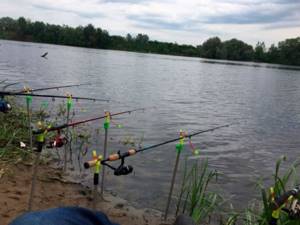
How to get there:
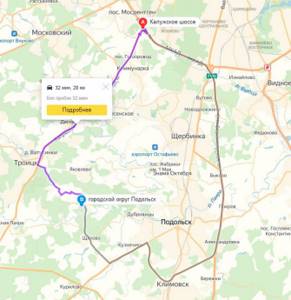
By car:
Along the Kaluzhskoe Highway in front of the village of Vatutinki, take the alternate and turn onto Vlasyevskaya Street, drive along this street to the village of Polivanovo. The river is located near the Polivanovo estate, 28 km from the Moscow Ring Road and half an hour’s drive. An alternative option is to drive along the Warsaw highway to the village of Oznobishino and turn towards the village of Shchapovo. Travel time will be approximately 35-40 minutes.
By public transport:
You can get to the river on your own from the Kursky railway station to the Podolsk station (1 hour on the way), from the station wait for bus 1034 to the village of Polivanovo, the travel time will be 40 minutes (19 stops).
Coordinates:
55.450490, 37.391486 (click on the coordinates to open the location on the maps)
How to choose the right place for fishing - the subtleties of a good catch
Ecology of life. Life: It turns out that just having normal gear and bait is not enough to catch fish. After all, choosing a good body of water, near which you can not only sit all your fishing time, but also catch a certain amount of fish, is also very important.
It turns out that it is not enough just to have normal gear and bait to catch fish. After all, choosing a good body of water, near which you can not only sit all your fishing time, but also catch a certain amount of fish, is also very important.
In general, choosing bait or tackle is not as difficult as it might seem at first glance. At least, there are quite a lot of “advisers” in these matters and they are not difficult to find. But as for where there are good and “catchy” places for fishing, in this case, it is unlikely that any of the experienced fishermen will be able to help you. Or rather, he definitely won’t want to do this.
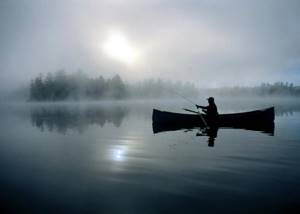
But even if you found such a body of water, this, as it turns out, is not enough. After all, it is still necessary to find places where fish would actually be caught. Moreover, a previously haunted place may suddenly turn out to be completely fishless, thereby causing great surprise on the part of the fisherman. And the reason for this lies on the surface. The fact is that fishing conditions change constantly and the bite can be influenced by a huge number of different factors, which even an experienced fisherman is not always able to keep track of.
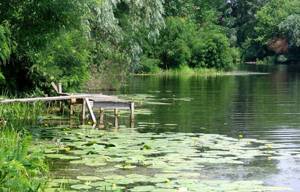
Almost perfect place for fishing
So, how to choose a fishing spot?
Just for successful fishing! Or maybe you can leave everything to chance and throw gear wherever you find it, with the secret hope that maybe a fish will bite? In this regard, it is useful to be guided by a simple rule of fish behavior. And it says that the fish always moves against the current, so to speak, “goes against the resistance of the water.” It follows from this that it would be useful for a fisherman to know all the whirlpools, riffles, holes and pits in a reservoir. It is in these places that the chances of catching fish increase several times.
If the river or lake is small in size, then it is much easier to look for places where fish are standing or feeding than in those reservoirs that have a large water area. In other words, the coastline and the visual visibility of the water flow help you “get attached” to a specific fishing spot.
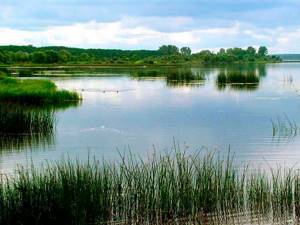
Plot on a large body of water
Very often, in such reservoirs, fish are found not only in holes or on riffles, but also near dense coastal vegetation. Moreover, the amount of fish in these places can be significant. If there is almost no current on the river or it is too slow, then the fish prefers places where the channel narrows, where the speed of the water flow increases slightly.
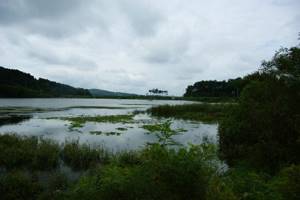
A place with little current
By the way, the presence of aquatic vegetation on a reservoir is one of the signs of the presence of a large number of fish in the reservoir. This is especially true for lakes, stakes, ponds and other bodies of water. Most stocking fish such as grass carp or silver carp like to feed on this kind of vegetation. As for rivers, the favorite places for fish to stay here are trees lying in the water, bridge piles, steep banks with the roots of coastal trees going under the water.
It must be said that grandfather Sabaneev gave advice on choosing a good place on the reservoir. And this advice remains relevant to this day. It lies in the fact that on any body of water all the “fishing spots” are located where there is a big difference between a certain section of the body of water and the general background. This means that all fishermen, sooner or later, must be able to “read” a body of water.
For example, if the river makes a sharp turn, then the depth of the river on the bank farthest from you will be greater in relation to “your” bank. Also, greater depth often occurs in narrow places in the river. Especially if the current in this place is not so strong. And, if you look closely, the color of the water at depth will be much darker than in shallow water. In this regard, it is useful to know the depth of the reservoir, because any fish looks for where it is deeper. Moreover, for this, it is not at all necessary to dive throughout the entire body of water and measure the depth.
In this regard, it is worth knowing that if the depth is up to a meter, then the plants usually grow here are sedge or susak. At a two-meter depth of the reservoir, reeds, cattails and pondweed grow. And if the depth reaches 3 m or more, then this can be determined by the presence of water lilies or filamentous algae. By the way, these plants can also be excellent “pastures” for fish.

Decrease in water level in a reservoir
In addition, an equally important factor for successful fishing is a sufficient water level in the reservoir. However, it should not be too high, because... in this case, the fish will simply go to spills or channels, where there is more than enough food for it. But if the water level for some reason begins to decrease, then the fish may even leave such places forever. If, of course, she has somewhere to go.
But, herbs are herbs, but before choosing a place to fish, it is advisable to decide what kind of fish you are going to catch. If the choice fell on tench, crucian carp or rudd, then it is advisable to look for deep places with strong thickets and a muddy bottom. Do you want to fish for gudgeon or dace? In this case, it is better to move to a place with a sandy bottom. But in order to catch an asp, you will have to throw gear into the pools located at the bottom of the rifts. True, such rules do not work in all cases, but this information still contains the main points.
In general, plant food occupies a significant place in fish food. However, everything ultimately depends on the type and size of the fish. Be that as it may, pondweed is considered the most attractive plant for fish. And I liked this plant because where it grows, the water begins to be enriched with oxygen. Although, many species of fish are not averse to having “breakfast” with filamentous algae. But as for such annoying duckweed, not all fish have a positive attitude towards it. Most likely, her attitude towards this plant is neutral and dismissive.
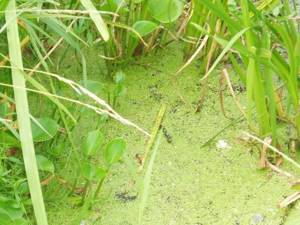
Duckweed as one of the types of aquatic vegetation
Fortunately, there are still good fishing spots. However, even in this case, upon arrival at a reservoir, you need to start fishing by inspecting it and choosing the most suitable areas on it. Having chosen one of these areas, you should try to make sure that the bottom is relatively clean and there are no snags or underwater thickets there. If this advice is neglected, the result may be a very quick hook and, as a consequence, breakage of the tackle. Determining the speed of the current is also an important factor. In many cases, the speed of water flow can be seen visually by watching sticks passing by or leaves falling from trees.
It must be said that experienced fishermen rarely focus on one particular body of water. For such people, fishing is a search. Be it searching for a reservoir, a fishing spot or the fish itself. From this we can draw a simple conclusion that it is necessary to fish every body of water that comes into view to determine the presence of fish in it and its quantity. Quite often it happens that in an unremarkable-looking body of water you can catch quite large fish. Therefore, even small bays should not be neglected either, because they are usually inhabited by perch and pike. But as for fishing in “bald” places, where there is no aquatic vegetation at all, this is a thankless task and a waste of time.
But some of the best places for fishing are places on those rivers that flow far from human settlements. Those. where artificial baits and fishing tricks are almost unknown to fish, but where there are natural shelters for fish such as underwater snags, stones, etc.
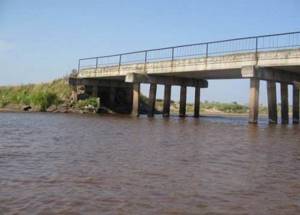
Bridge with piles going under water
Places are different, and all fishermen should know some factors that affect the bite and catch of fish. And such factors include signs of fish accumulation areas.
So, the fish tries to hold on:
- in snarled areas of a reservoir or near dense coastal vegetation;
- near bridges, rafts and crossings;
- at the confluences of small rivers with the main ones, where there is sufficient depth and flow speed.
In addition, the most common feeding places for fish include the following:
- places of rivers with strong currents and areas where the current slows down;
- “non-standard” places on the reservoir;
- evening and morning dawn.
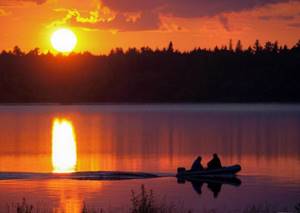
Fishing at dawn
Video - choosing a place for fishing
SUBSCRIBE to OUR YouTube channel Ekonet.ru, which allows you to watch online, download free videos from YouTube about human health and rejuvenation. Love for others and for yourself, as a feeling of high vibrations, is an important factor
Conclusion
In general, fishing is a search. And it is especially productive in those reservoirs that are located outside the city limits. For example, in some cases you can fish at those moments when a herd of cows enters a river or lake to drink. The fact is that with their feet they lift a mass of sand and silt, along with which underwater living creatures rise. And so the fish try to feast on it, swimming closer to such places.
Of course, even if you know a good body of water and choose the ideal place for fishing, you may not catch anything at all, because every rule has its exceptions. And fish live their own lives, the meaning of which, alas, man will never know. But we must strive for this! published
Please LIKE and share with your FRIENDS!
https://www.youtube.com/channel/UCXd71u0w04qcwk32c8kY2BA/videos
Subscribe -https://www.facebook.com/econet.ru/
PS And remember, just by changing your consumption, we are changing the world together! © econet
Pond Vasyunino
The clean water area with shores free of vegetation and numerous approaches to the water attracts lovers of catching peaceful and predatory inhabitants of the ichthyofauna. There are summer cottages around the lake, so local fishermen compete with visiting vacationers. In many articles, this place is mistakenly called “Vasyutino pond,” which is a misconception, since Vasyutino is located in a completely different direction.
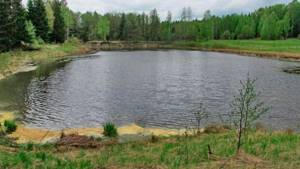
How to get there:
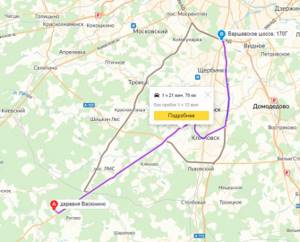
By car:
Along the Warsaw highway, passing Podolsk, we go to the sign for the village of Vasyunino, turn and almost immediately find ourselves in a village with a pond. From the Moscow Ring Road the drive is about an hour and 68 km.
By public transport:
The easiest way to get there by public transport is from the Teply Stan metro station. Take bus 503 and go to the stop “Povorot na Vasyunino” (1:40 hours on the way, 62 stops), then you need to walk about 2 km.
Coordinates:
55.241048, 37.009540 (click on the coordinates to open the location on the maps)
Lykovsky Pond
If you want privacy, then you should leave Vasyunino and drive a few more kilometers. Moving through the field along a dirt road, another body of water looms before the eye. Unsociability and pristine nature are what is so necessary for a modern person who has chosen to take a break from the concrete jungle. The reservoir is surrounded on almost all sides by forest and only on one side by meadow. The water area is rich in carp fish species, as well as predators. Fishermen often visit Lykovsky Pond with a spinning rod, tempting perch and pike to bite.
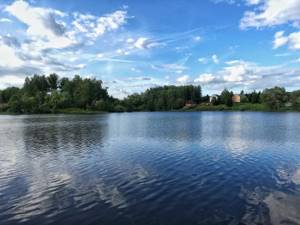
How to get there:

By car:
The pond is located 2 km from Vasyunino in the village of Lykovka. Travel time increases by only 10 minutes
By public transport:
You can repeat the route to the “Turn on Vasyunino” stop, but then you will have to walk about 6 km. Therefore, if you want to get to the pond without a car, then it is better to get from the Teply Stan metro station on minibus 887 to Voronovo station (a little over an hour on the road, 42 stops), and from there call a taxi to the village of Lykovka (about 20 minutes drive)
Coordinates:
55.248028, 36.972808 (click on the coordinates to open the location on the maps)
Bear Lakes
If you want to fish from a boat, then Bear Lakes is your best choice. You can get to them either by your own transport or by bus, heading along Shchelkovskoye Highway. There is a private farm on a large lake, so fishing here is paid. However, you can fish in a nearby reservoir without paying any money. There you can catch crucian carp, roach, and on spinning rods – perch and pike. They fish on the lake both with spinning rods and with live bait. Among the usual prey there is also an eel, which will be a real crown of the fishing day. Fishing from the shore is not the best idea, since the lake is surrounded by a dense wall of reeds, and there are few approaches to the water.
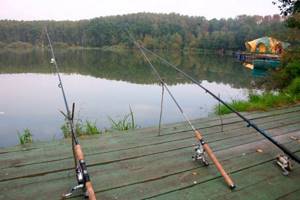
How to get there:
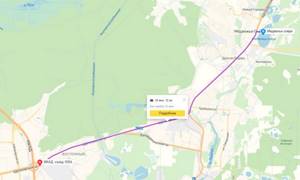
By car:
Bear Lakes are located 12 km from Moscow along the Shchelkovskoye Highway. You need to get to the village “Bear Lakes”, the time in Pui will be 22 minutes.
By public transport:
From the Shchelkovskaya metro station by bus (320, 321, 335k, 349, 361, 371, 378, 380, 429 - 11 stops), or by minibus 485k to the Medvezhye Ozera stop, the travel time will be 27-30 minutes. From the stop you will immediately see the lakes; you can walk to them in 5-15 minutes.
Coordinates:
55.864334, 37.997368 (click on the coordinates to open the location on the maps)
Choosing a good place for fishing on the lake
The answer to the question posed in the title suggests itself: yes, there are fish in the vast majority of lakes in Russia. The whole question is where exactly she likes to be, and what method of fishing to catch her.
Common Mistakes
Experienced fishermen, arriving at a new body of water, are in no hurry to immediately cast their fishing rods in the immediate vicinity of the car or parking lot. This “technique” justifies itself only if fishing is not the most important attribute of relaxation.
Another most common mistake is to sit in the place where there is the largest concentration of anglers. Firstly, if there are fish in this area, most of them may have already been caught. Secondly, those who came earlier may regard such actions as an invasion of their territory.
Thirdly, proximity to a noisy company is beneficial only to lovers of jokes and fishing tales. Another common mistake is that the place is chosen on a clean, flat section of the coast, and the fisherman, apparently, proceeds from considerations of convenience.
Unfortunately, fish often don’t think so, preferring to be where it is convenient for them.
Selecting a location
If you fish in winter, then you should take into account that during the dead winter period, fish prefer sections of the river with a current. There is more oxygen here, the lack of which at this time of year the fish are very sensitive.
Pits, although they serve as a place for significant accumulation of fish, also have their negative side: the bite here is sluggish, more dependent on weather conditions and requires a certain sophistication in choosing bait and bait.
If you have chosen an area with moving water, you should keep in mind: the fish take best at the junction of fast currents and standing water. The same applies to the edges that run along the entire underwater river bed and serve as a favorite stopping place not only for roach, but also for perch, as well as other predators.
There are also good entrances to and exits from pits. In this case, it is better to drill several holes to measure the depths in order to choose the optimal location. Good places are where streams flow into a river (or lake). There is also a factor of fresh, more oxygenated water here.
Less pleasant, but often more productive, is fishing in places bordering flooded trees, bushes, and snags. Here you can also catch a decent specimen of a predator. In summer, it is advisable to look for narrow places, bays protruding into the shore, or, through preliminary measurements, to feel the edges along the edges of holes and the river bed.
Fishing at night
Night fishing is a completely different matter. Here it should be taken into account that at night the fish come out to shallows abundant with food. And not only small, but also large. In this case, it is necessary to maintain absolute silence, because the larger the fish, the more timid it is.
However, there are times when large fish are caught in almost the busiest swimming area. But this is rather an exception to the rule. Fishing gear for fishing at night is often aimed at catching large fish. If these are fishing rods, then more durable ones, equipped with reels. You can use fishing rods with live bait or whitebait bait.
The feeder is most often used, regardless of whether you are going to catch carp, crucian carp or predatory fish.
Favorite places
When choosing a fishing spot, you should always keep in mind several factors: the time of day, the nature of the reservoir, what kind of fish you would like to catch, and much more. For example, in summer, fish can be caught in shallow water, especially since quite often roach, rudd, crucian carp and crucian carp come here in search of rich food of both plant and animal origin.
You should look for “windows” in the grass thickets, and if the river section is without them, then it is better to fish at the edge of the thickets and clear water. Moreover, the bait can be not only traditional maggots, bloodworms or dough with “heart” drops, but also green grass growing in the water, bugs, slices of the “tongue” of shells, in a word, everything that the fish are already accustomed to eating here.
It should be taken into account that on a hot afternoon, fish, as a rule, move from shallow places into the depths, and in the evening, on the contrary, they rise from the depths. If a section of the river is illuminated by the sun, then you need to look for darkened places, where shadows from trees or bushes fall on the water.
Sometimes it is enough to find a hole on a flat area, a place with a reverse current, the end of a riffle or a lull on it below a large stone or group of stones - and the catch is guaranteed! Various types of artificial structures have proven themselves well.
The fish willingly stays below dams and locks, where old bridge piles stick out of the water, which means there are uneven spots that have been washed away by the river’s flow over many years. Places under bridges are good because from here all sorts of fish food flies into the water. And if it rained heavily the day before, then the best place is at the confluence of streams, on the border of light and muddy water.
It is these “contradictions” that often create a fisherman’s success. On narrow rivers you need to look for widening; this is probably a hole, at the entrance and exit of which your fish is waiting for you. In wide areas you should look for narrow spots. If the river is deep, look for sandbanks, and in shallow rivers, look for holes.
Diary
And one last piece of advice. Regardless of whether the day turned out to be abundant in catch or not, it is advisable to write down your observations, impressions and conclusions in some book or journal. Then, over time, by re-reading and analyzing your notes, you can accurately determine where and what kind of fish can be caught even in an unfamiliar body of water.
Source: https://ozera.info/fishing/fisher/methods/vybor-udachnogo-mesta-dlya-rybalki-na-ozere
Holy Lake
The main feature of this reservoir is its non-freezing water surface. Fans of fishing with summer gear can enjoy their favorite activity all year round. The lake is quite deep, so there is a minimal amount of vegetation in its waters. Bream, crucian carp, pike perch and pike are not the only representatives of this water area. A vast water area with an area of 1200 hectares is surrounded by trees, as well as industrial complexes, which slightly spoils the overall landscape. This place is not suitable for those who like fishing alone, far from civilization, but fans of fishing from a boat can always use the services of rental companies who rent out boats right on the shore of the lake.
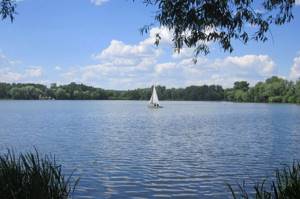
How to get there:
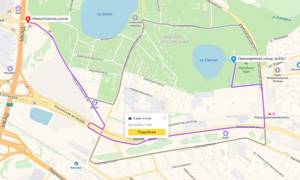
By car:
The lake is located 2.5 km from the Moscow Ring Road along the Novoukhtomskoye Highway, exit onto Kosinskoye Highway and after a Shell gas station (nearby is the Dmitrievskogo Street metro station), turn left onto Saltykovskaya Street and drive to Kosinsky Park. (An alternative option is to turn from Novoukhtomskoye Highway onto Bolshaya Kosinskaya Street, passing Kosinskoye Highway, or go straight to Kosinskoye Highway)
By public transport:
Due to the opening of the metro in the summer of 2021, getting to the place has become very easy. Get to the Ulitsa Dmitrievskogo metro station and walk towards Kosinsky Park (about 800 m and 11 minutes).
Coordinates:
55.715170, 37.868984 (click on the coordinates to open the location on the maps)
Looking for and catching pike from the shore
On a familiar river or lake, where fishermen fish often and already know all the good places, there are no special problems with fishing. But where the angler came for the first time, difficulties may initially arise with choosing a place to fish. You shouldn’t start fishing at random in the first place you come across. First you need to look around and try to identify promising places where there is a chance of finding and catching pike.
First of all, you need to look out for grass and various snags sticking out of the water. Even a small tuft of vegetation protruding to the surface can be the location of a pike in this particular place of the reservoir. On many lakes and rivers near the shores you can often find water lilies and reeds. This is where you should try to start catching. To begin with, you should try fishing near the edge of the grass. And if there is no result, then you can switch to casting directly into the grass itself. You just need to choose the appropriate bait for this. Otherwise, the pike will simply be scared away by the hooks, and not caught.
It is difficult to fish in thick grass and reeds. The only thing that will help here is a good oscillating “non-snag.” But among the water lilies you can relatively calmly move a rubber fish and even a wobbler. You just need to choose a place where the grass is sparse, or there are ready-made windows among the water lilies. It often happens that the pike stands in the grass right next to the shore. Therefore, you should not immediately approach the very edge of the banks, but first cast from a certain distance from the edge.
If a fisherman spooks a pike, it usually does not swim very far. Sometimes, after swimming a few meters to the side, you can even see how the fish stopped in a new place convenient for it. If the bite is good, the pike may bite and not immediately catch on the hook. In such cases, it is worth making several casts to the same place. It often happens that with the next such cast there will be another bite from the same fish.
Read: Wobblers Zipbaits Rigge 90F
If there are no bites in the grass, you should try to fish the area adjacent to it. Pike can only enter the grass to hunt, and then stay nearby. It is also worth making casts in all directions and throwing the bait both away from the shore and along it. In a word, fish the entire adjacent space.
Stumps, snags and trees that have fallen into the water that stick out from the water should also be carefully caught from all sides. The pike will not necessarily be located directly under the snag itself. She often hangs around somewhere.
If a river or stream flows or flows into the lake, then such places also attract pike. In summer, such a place brings coolness, and pike, following small fish, is drawn to such places. In addition, river beds usually have differences in depth, and this is just what is needed for pike. There are convenient places to hide and hunt. And if there is also grass nearby, then there simply cannot be fish in such a place, and such places must be carefully fished.
If there are steep banks on a reservoir, then under them there are usually various underwater niches in which it is very convenient for pike to hide. Here it is worth leaving and leading the bait both along the shore and a little further away. And of course don’t forget to cast in all directions. Away from the shore in the water there are often submerged logs, bushes, stones and other irregularities behind which pike can hide. When such places are visible, it is not difficult to decide where to cast. The remaining places are determined and found only experimentally.
On rivers, good places are bends in the riverbed and places with little or no current. Pike does not like rapids and sticks to quieter places. However, if there are places where the water turns in the opposite direction, or goes around any obstacles, then pike can be found here, despite the presence of a current, even a fairly fast one. Particular attention should be paid to quieter backwaters, spills and various obstacles that are found in the river along its entire length. Any place like this is worth trying your luck. And of course, grass will always be an attractive place for pike, as well as places where secondary streams flow into or flow out of the main river.
Murom Lake
Not far from the previous fishing spot is the Muromsky reservoir. It is known to experienced fishermen for its abundance of peaceful fish. Today's catches include bream, roach, carp and even ide. Nature is not much different from the landscapes on Holy Lake. The same trees and the top of the local power plant are visible to the eye. Vacationers are often found along the shores, so you should choose a place for fishing away from noisy companies.
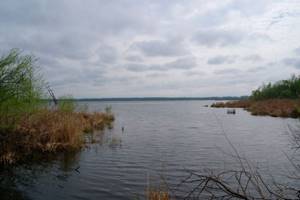
How to get there:

By car:
The lake is located in Shatura, about 130 km from the Moscow Ring Road. From the Moscow Ring Road you need to turn onto Lermontovsky Prospekt, then you need to turn onto Yegoryevskoye Shosse (towards Yegoryevsk, the sign will point directly to Zhukovsky). Then, before reaching Yegoryevsk, turn towards Antsiferovo (the sign will indicate that it is 33 km to Yegoryevsk). Passing Antsiferovo we will get onto the A-108 highway, turn right and go to the Shatura highway (there will be a sign for Shatura), pass Shatura and continue driving along the highway after the railway crossing there will be a left turn into the forest (with a large banner “Save the forest!”) . Then we follow this road to the lake. Travel time will be about 2.5-3 hours.
By public transport:
The easiest way is to get from the Kazansky railway station to the Shatura or Botino stop (about 2.5 hours on the road). From Shatura you can call a taxi (the journey is 10 km, 25 minutes, but after entering the forest the road will not be paved), or from Botino station you can walk 2.7 km (about a half-hour walk).
Coordinates:
55.572255, 39.585898 (click on the coordinates to open the location on the maps)
White Lake
The free reservoir is located above the local thermal power plant. Bottom fishing methods are popular there: feeder and cast. Carp often sit on the hook, so you need to arm yourself with powerful tackle. Fine groundbait will attract small roaches, so when fishing for carp it is worth using a mixture of broken peas, corn and other relatively large particles. Sloping banks with a hard bottom make it possible to place a large amount of gear. White Lake is perfect for both amateur fishing and a family picnic.
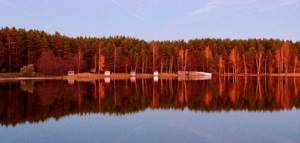
How to get there:

By car:
The lake is located 13 km from the Holy Lake. Driving as before the Holy Lake, but without turning off, continue driving along the Shatura highway, after the village of Borduki (before reaching the village of Vlasovo) you will see a large lake to the left of the road, immediately after the lake there will be a turn to the left.
By public transport:
The easiest way will be to get from the Kazansky railway station to the Shatura stop (about 2-2.5 hours on the way). From Shatura, take bus 26, 32, 32/26, 369m, 376, 376b, 47 and go 16 stops to the “White Lake” stop (about 40 minutes on the way).
Coordinates:
55.634039, 39.739734 (click on the coordinates to open the location on the maps)
Moscow Canal
A long canal connects two reservoirs. Along the bank of the canal you can find countless promising places where perch, silver bream, bream, as well as other types of fish that are popular in the Moscow region bite. A feeder or match is perfect for fishing, since the edge, as a rule, is located away from the shore. The best results were shown by animal types of baits, such as maggots, bloodworms and red worms. There are large stones on the bank of the canal, and the average depth of the water area is 4-5 meters. Running water quickly carries away a light load, so experienced fishermen use a lead weight of 80 grams or more. And if you love airplanes, you can also take a ride to the Sheremetyevo glide path, which is a 15-minute drive away (glide path coordinates - 55.979001, 37.453913). Where you can see planes landing from the very first row.
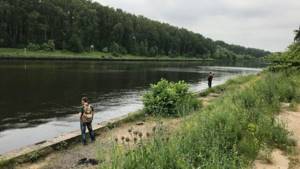
How to get there:
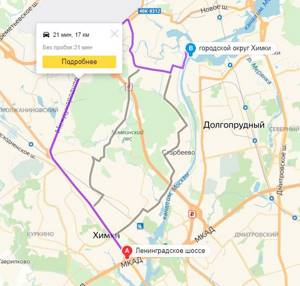
By car:
From the Moscow Ring Road, turn onto Leningradskoe Shosse, then follow towards Sheremetyevo Airport (turning onto Mezhdunarodnoye Shosse). Right in front of the airport, turn onto Sheremetyevskoye Highway, driving along it after the Lukoil gas station, turn right, driving straight towards the Bereg residential complex. When you reach the junction near the Bereg residential complex, you need to turn left towards Ivakino. On the right side you will already be able to see the Canal named after them. Moscow. From the Moscow Ring Road the distance is 17 km and 26 minutes drive. Since the Leningradskoye Highway has been heavily loaded and jammed lately, there are 2 alternative routes: a toll road to St. Petersburg and through the Dmitrovskoye Highway (turn onto the New Highway towards Sheremetyev Airport, then you get to the Sheremetyevskoye Highway (also a Lukoil gas station, only now on the right side) turn left.
By public transport:
From Leningradsky station you get to Khimki station (22 minutes travel time). Next, take bus 11 or 17 and get to the “Magazin” stop (14 stops and 22 minutes on the way). Then walk about 800 meters to the Moscow Canal.
Coordinates:
55.957336, 37.484516 (click on the coordinates to open the location on the maps)
Features of autumn fishing
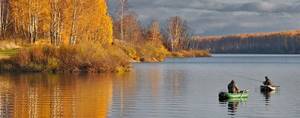
In autumn, the Moscow region is good for catching predatory fish and fishing from a boat. Due to the cool climate, fish become scarce off the coast. Predators are trying to stock up on fat for the entire winter, and therefore become more active and move around a lot. The easiest way to catch pike at this time of year is to catch perch, pike perch, asp, and crucian carp. Beautiful views of autumn nature from a boat seem even more magical, so you can get twice as much pleasure from such a vacation.
Moscow River in Ramensky district
An excellent place for fishing in winter, when the river drops to its lowest level, exposing the banks on which you can comfortably sit with both bottom gear and easily travel many kilometers with a spinning rod in search of the coveted pike perch and pike.
In summer, the water is at its maximum level, but you can still find quite a few places in the Sofiino area and even more in Bronnitsy and below. But don’t forget the main thing: you can go out on a boat at this time, and of course remember the spawning ban.
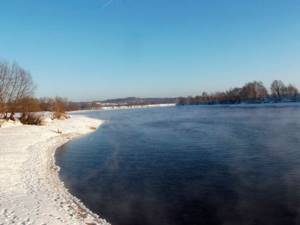
How to get there:
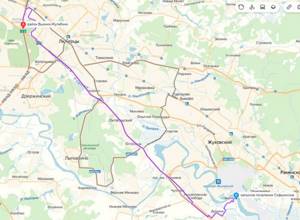
By car:
From the Moscow Ring Road you turn onto Novoryazanskoye Highway and drive along it towards the working village of Oktyabrsky. When you see a sign indicating a right turn towards Volodarskoye village and Neftebaza, get ready to turn right onto Ryazanskoye Highway. Driving along the Ryazanskoe highway, turn left when you see a sign for Durnikha and drive over the Novoryazanskoe highway. Arriving in Durnikha, do not turn off the main road and reach the village of Vertyachevo. You're at the place.
By public transport:
From the Kotelniki metro station, take a minibus and go to the village of Durnukhi and the Durnikha stop, 58A (24 stops, 45 minutes on the way). Next you will have to walk 3.5 km towards the village of Vertyachevo.
Coordinates:
55.547575, 38.143700 (click on the coordinates to open the location on the maps)
Fishing on the rivers of the Moscow region, free fishing
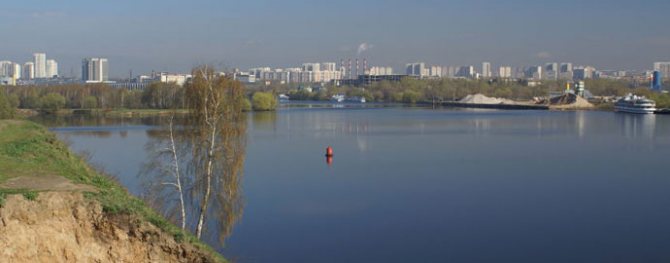
Although the Volga River is very large, fishing in the Moscow region is possible only near the city of Dubna. Here, below the Ivankovo Reservoir, perch, pike perch and asp are well caught on the current using a spinning rod. Feeders here mainly catch bream.
The Moscow River is the main water artery of the Moscow region, through which it flows completely. Fishing here is allowed and possible with all gear. And there are plenty of fish, both predatory and peaceful. But the condition of the water is very poor and it is very polluted.
Pekhorka is a small river only 44 km long. but very often visited by fishermen. It has one peculiarity: it does not freeze in winter, and here you can fish in open water with a spinning rod all year round.
The Moscow Canal is another main body of water among fishermen in the Moscow region. Fishing here is possible with all gear, but preference is given to feeder and float rods. There are a lot of white fish here, and competitions are held to catch them. The constant change in the speed of the current by the locks makes fishing here quite difficult, but still interesting.
The Oka River is a favorite body of water for many fishermen in the Moscow region. It has a lot of interesting places in the relief, from fast rapids to deep pools. There are a lot of asp and pike perch here, which are hunted by spinners. Bream and, less commonly, roach make up the main catch of feeders and floaters.
Pakhra is a right tributary of the Moscow River, 135 km long. In the upper reaches, where the width is only 3-5 meters, you can fly fish for chub. The main species composition of fish in the Moscow region is found in the lower reaches.
Severka is the right tributary of the river. Moscow is almost 100 kilometers long. Fishing here is quite difficult due to constant pressure from fishermen and poachers. Although there are still big trophies here.
Ruza is a river in the Moscow region on which the Ruza Reservoir is located. Below which bream, asp, chub, ide, roach, and perch are very well caught. The upper part of the stream is fixed - as a reservoir for amateur and sport fishing.
Klyazma is quite an interesting body of water for fishing in the Moscow region, although it is very polluted. Therefore, many fishermen from this river do not eat fish.
Dubna - flows in those regions - Moscow, Vladimir, Tverskaya, the right tributary of the Volga. Fishing is interesting near the villages of Bolshoye and Maloe Strashevo, Novonikolskoye. Inhabited by roach, bream, dace, pike, perch.
Sturgeon is another river in the Moscow region more than two hundred kilometers long, the right tributary of the Oka.
Lopasnya is a left tributary of the Oka, 108 km long. The main fish species living here are chub and perch. roach, small pike.
The Protva is a right tributary of the Oka, flowing in the Moscow and Kaluga regions. The upper part of the river is located in the Moscow region and fishing here is possible with a spinning rod, float rod, or fly fishing.
Nerskaya is a small river in the Moscow region, 92 km long, abounding in small pike, perch and roach.
The Nara is the left tributary of the Oka, from which comes many different fish of interest to the angler.
Besputa is a narrow and very winding river with a slow flow. Although it is small, only 70 km, there are quite a few pits (pools) with a depth of about six meters.
Ivankovskoye Reservoir - Volga River
A relatively close place from Moscow for fishing in a wonderful place near the city of Dubna.
Heading along the Dmitrovskoye Highway towards the reservoir, on your left you will see the Moscow Canal, which in turn is fraught with many surprises and will also serve as an excellent place for fishing before reaching the main place. In the summer season, a huge number of bottom tackle lovers settle down along the canal in the hope of catching trophy bream and other peaceful inhabitants of the local reservoir, the artery of which flows into the Volga.
If you follow your cherished goal, reaching the reservoir, then one of the most popular places for feeder fishing is the peninsula, which you can get to by driving through the “Dubna Bridge” and then turning left in the direction of Dmitrovskoye Shosse, passing the underground tunnel and a little straight ahead, you you will run into a huge area of cubic meters of water, the main landmark of which on the left side will be the monument to V.I. Lenin. Here you will find a truly inspiring place to do what you love.
Fans of spinning rods can enjoy this place with an abundance of asp, pike perch, bersh and pike, but only with the use of a long coastal jig, capable of sending bait 70 meters from the shore. But the best option in this place for spinning anglers would be a “boat”, because... a wide water area will fully reveal itself only at great depth.
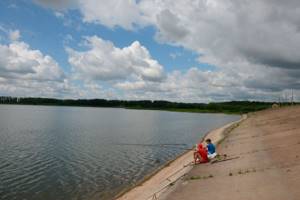
How to get there:

By car:
Drive along the Dmitrovskoe highway to the city of Dubna (the sign will be on your left), after passing the sign, after about 1-2 km (the very first turn on the right), turn onto the New highway, driving almost 3 km, turn onto Priborostroiteley street, pass bridge and at the roundabout turn street. Makarenko (3rd exit), go straight to the end, where there will be a left turn (Zhukovskogo Street) and along the main road turn right onto Dmitrovskoye Shosse, pass the bridge and you are there. The travel distance from the Moscow Ring Road is 110 km, the travel time is about 2 hours.
By public transport:
From Savelovsky station, take the train and go to the “Bolshaya Volga” stop (2:15 hours on the way), go to the bus station and take bus 6 to the “Levoberezhnaya” stop (10 stops), from it 1 km on foot across the bridge.
Coordinates:
56.731492, 37.123082 (click on the coordinates to open the location on the maps)
Winter fishing in the Moscow region
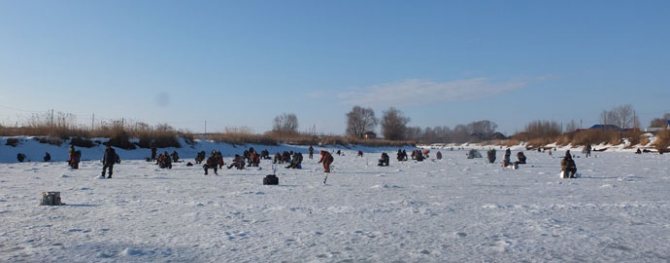
The number of places for fishing in winter in the region is noticeably decreasing. Mostly, paid reservoirs remain accessible, in which stocking is maintained throughout the year. But ice fishing enthusiasts will be able to catch trout and carp - species of fish that under normal conditions go down and hibernate during the winter. But if the quality of fish during winter fishing is not as important to you as the process itself, then you can find a suitable place without paying for it. When choosing paid fishing in winter, you can consult with specialists from private households about the use of this or that device.
